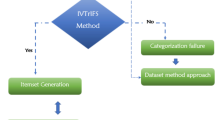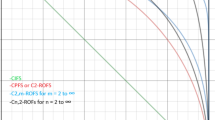Abstract
This paper gives a way of analyzing decisions in the case of unknown utility function, or more precisely, when we know only a linear order on an income space. It is shown that in this situation, decisions and corresponding probability measures are partially ordered, and this order is identical to the inclusion relation of comonotone fuzzy sets. It enables us to use inclusion indices of fuzzy sets to analyze the comparability of decisions. To do this, we introduce an inclusion index having properties, which are close to ones of the classical expected utility.

Similar content being viewed by others
Notes
Actually, this order \(\preceq \) on probability measures coincides with the first order stochastic dominance if \(R\) is a real line.
One can find the proof of this proposition in (Bronevich and Karkishchenko (2002), Theorem 5, p. 192).
We can define the inclusion index for general case as \(\psi (F_1 \subseteq F_2 ) = \int \nolimits _0^1 {w(p)\psi _p (F_1 \subseteq F_2 )dp} \), where \(w\) is a non-negative weight function with \(\int \nolimits _0^1 {w(p)dp} = 1\). Here we assume that \(w(p) = 2p\). This assumption leads to the properties of inclusion index, which are close to ones of the classical expected utility functional.
This theorem follows directly from Property 3 given in the next section.
References
Aiche, Fq. (2010). An extension of stochastic dominance to fuzzy random variables. In E. Hüllermeier, R. Kruse, & F. Hoffmann (Eds.), Proceedings of IPMU 2010, LNAI 6178 (pp. 159–168). Berlin-Heidelberg: Springer.
Aliev R. A., Pedrycz W., Alizadeh A. V., & O. H. Huseynov. (2013). Fuzzy optimality based decision making under imperfect information without utility. Fuzzy Optimization and Decision Making. Published online: 3 May 2013.
Borisov, A. N., & Krumberg, O. (1983). A theory of possibility for decision-making. Fuzzy Sets and Systems, 9, 13–24.
Bronevich, A.G. (2006). The construction of inclusion indices on the set of fuzzy measures and their application in decision-making. In Proceedings of international conference on information processing and management of uncertainty in knowledge-based systems (IPMU-2006), Paris-France (pp. 1761–1767).
Bronevich, A. G., & Karkishchenko, A. N. (1994). The family of proximity measures of expert estimates and selection of the optimal measure. Automation and Remote Control, 55, 568–575.
Bronevich, A. G., & Karkishchenko, A. N. (2002). Statistical classes and fuzzy set theoretical classification of possibility distributions. In C. Bertoluzza, M. A. Gil, & D. A. Ralescu (Eds.), Statistical modelling, analysis and management of fuzzy data (pp. 173–195). Heidelberg: Physica-Verlag.
Danielson, M., & Ekenberg, L. (1998). A framework for analysing decisions under risk. European Journal of Operational Research, 104, 474–484.
DeGroot, M. (1970). Optimal statistical decisions. New York: McGraw Hill.
Denneberg, D. (1997). Non-additive measure and integral. Dordrecht: Kluwer.
Denneberg, D. (2000). Non-additive measure and integral, basic concepts and their role for applications. In M. Grabisch, T. Murofushi, & M. Sugeno (Eds.), Fuzzy measures and integrals—theory and applications. Studies on fuzziness and soft computing (pp. 153–168). Heidelberg: Physica-Verlag.
Denneberg, D., & Grabisch, M. (2004). Measure and integral with purely ordinal scales. Journal of Mathematical Psychology, 48, 15–26.
Denoeux, T. (2009). Extending stochastic order to belief functions on the real line. Information Sciences, 179, 1362–1376.
Dubois, D., & Prade, H. (1985). Possibility theory. New York: Plenum press.
Dubois, D., & Prade, H. (1987). The mean value of a fuzzy number. Fuzzy Sets and Systems, 24, 279–300.
Dubois, D., & Prade, H. (2003). Ranking fuzzy numbers in the setting of possibility theory. Information Sciences, 30, 183–224.
Dubois, D., Prade, H., & Sabbadin, R. (2000). Qualitative decision theory with Sugeno integrals. In M. Grabisch, T. Murofushi, & M. Sugeno (Eds.), Fuzzy measures and integrals—theory and applications (pp. 314–332). Heidelberg: Physica Verlag.
Dubois, D., Grabisch, M., Modave, F., & Prade, H. (2000). Relating decision under uncertainty and multicriteria decision making models. International Journal of Intelligent systems, 15, 967–979.
Fishburn, P. C. (1964). Decisions and value theory. New York: Wiley.
Giron, F. J., & Rios, S. (1980). Quasi Bayesian behaviour: A more realistic approach to decision-making. In J. M. Bernardo, J. H. Degroot, D. V. Lindley, & A. F. M. Smith (Eds.), Bayesian statistics (pp. 17–28). Valencia: University Press.
Gilboa, I., & Schmeidler, D. (1989). Max-min expected utility with non-unique prior. Journal of Mathematical Economics, 18, 141–153.
Keeney, R. L. (1974). Multiplicative utility functions. Journal of Operations Research, 22, 22–34.
Litvak, B. G. (1990). Expert information: Methods of extracting and analysis. Moscow: Radio I Svyaz Publ (in Russian).
Savage, L. G. (1972). The foundation of statistics (2nd ed.). New York: Dover.
Von Neumann, J., & Morgenstern, O. (1944). Theory of games and economic behavior. Princeton: Princeton University Press.
Walley, P. (1991). Statistical reasoning with imprecise probabilities. London: Chapman and Hall.
Wang, X., Ruan, D., & Kerre, E. E. (2009). Mathematics of fuzziness—basic issues. Studies in fuzziness and soft computing (Vol. 245). Berlin-Heidelberg: Springer.
Zadeh, L. A. (1978). Fuzzy sets as a basis for a theory of possibility. Fuzzy Sets and Systems, 1, 3–28.
Zarei, R., Amini, M., Rezaei Roknabadi, A. H., & Akbari, M. G. (2012). Some fuzzy stochastic orderings for fuzzy random variables. Fuzzy Optimization and Decision Making, 11, 209–225.
Author information
Authors and Affiliations
Corresponding author
Rights and permissions
About this article
Cite this article
Bronevich, A.G., Rozenberg, I.N. Ranking probability measures by inclusion indices in the case of unknown utility function. Fuzzy Optim Decis Making 13, 49–71 (2014). https://doi.org/10.1007/s10700-013-9169-6
Published:
Issue Date:
DOI: https://doi.org/10.1007/s10700-013-9169-6




